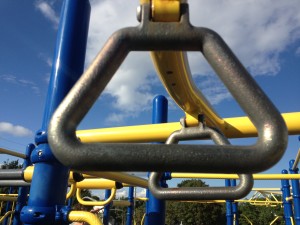I’ve written a handful (get it?) of posts on elements of hanging and swinging to support the Mouse Hands to Monkey Arms section of my book Move Your DNA. Recommended reading order is Hanging and Swinging 101, Hanging and Hand Skin, Upper Body Terrain, and Upper Body Texture. These posts have been updated November 2018 for easier use.
Setting aside what you do most frequently with your hands, probably type on the computer or teeny tiny screen, consider your most frequent upper body work. Do you always reach for the same handles, bars, or dumbbell shape?
Repetitive hand-surface-shape is limiting because it sets you up to be strong in a single way. Yes, you can increase the weight you can lift in that particular way (i.e. you can can get stronger in that way of moving), but you wouldn't necessarily be making more of your body strong.
This is the second post in a "cross-training is broader than you think it is" series. Pick an exercise, like a pull up, or chin up, or hanging, or swinging. And instead of pulling or pushing off of the same shape of thing that you always use, use different parts of your body, or the same parts differently, by changing your hand-terrain. I've written and spoken a lot about this over the years, but I'm trying to use fewer words and more pictures to really drive home the point.
These are all things you can hang from, but they don't all move you the same way:
Different bar angles, bar girths, shapes, and wobbliness of the thing you're connecting your body to, require different ways of using your body. So the "same" exercise of "hanging" really isn't the same at all. Your body is being moved by your environment so changing your equipment is to change the way you're moving.
P.S. This also goes for the texture of what you're hanging from.






